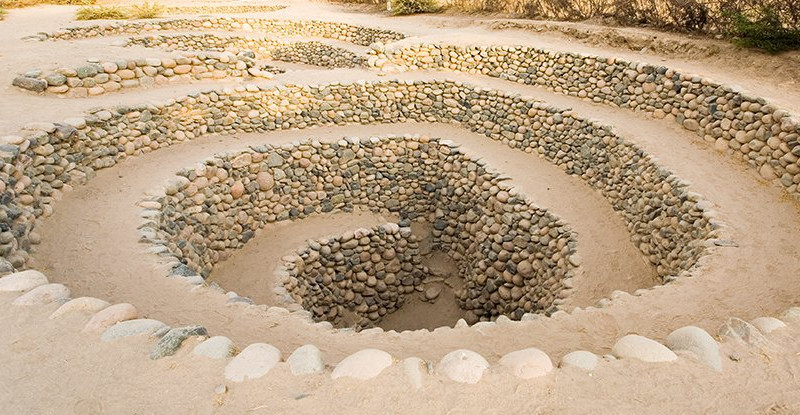Strange spiral holes in the Peruvian desert
The magnificent spiral holes in the Peruvian desert are actually a network of irrigation tunnels, helping people take groundwater and survive in dry weather.
According to Science Alert, the Nasca desert in southern Peru is home to many spiral holes dug deep into the ground, called puquios . These special structures cannot use carbon isotope analysis to date. Nor did the Nascas leave any evidence of the time and purpose of building them.

Strange spiral holes in the desert in Peru.(Photo: Pikselstock).
Rosa Lasaponara of the Institute of Environmental Analysis Methods, Italy, uses satellite images to draw puquios distribution diagrams, and learns their links to nearby residential areas. As a result, spiral pits are located in a network of irrigation tunnels in the Nasca desert, helping people get groundwater. Lasaponara plans to publish his findings later this year in an article entitled " The Ancient Nasca World: A New View from Science and Archeology".
"The puquios system helps exploit endless water resources throughout the year, contributing to promoting intensive agriculture in the arid valley area. Technology for construction and regular maintenance of spiral holes based on integration Great cooperation and effort of the social organization system , " Lasaponara said.
Spiral pits operate by transporting wind into underground channels, putting pressure on water from deep underground water tanks to where they need to be used. The construction of a large-scale project such as the puquios system requires a comprehensive understanding of regional geology, as well as the transformation of the annual water supply.
"The puquios system is the most ambitious irrigation project in the region of Nasca, which allows water resources to be available year-round for use, not only for agriculture but also for domestic needs", Lasaponara explained. prefer.
- Decipher the mysterious sign in the Egyptian desert
- Picture of a 70-meter killer whale in the Peruvian desert
- Discover the largest pair of black holes near Earth
- Find out how to weigh black holes: use galaxy spiral arms
- Discovered the ancient whale fossils in the Peruvian desert
- The most exotic deserts in the world
- Mysterious decoding of strange ice holes constantly appearing in Antarctica for decades
- Discovered more than 20 strange giant drawings in the desert of Peru
- Strange drawings on the desert
- Experience the feeling of
- The metal sphere fell after the explosion that panicked the Peruvian people
- The phenomenon of snowfall is very strange in the Atacama desert
 The truth about the mysterious red-haired giant at Lovelock Cave
The truth about the mysterious red-haired giant at Lovelock Cave Inunaki Tunnel: The haunted road leading into Japan's 'village of death'
Inunaki Tunnel: The haunted road leading into Japan's 'village of death' The mystery of the phenomenon of human reflection before dying
The mystery of the phenomenon of human reflection before dying 6 mysterious phenomena, although science has been developed for a long time, still cannot be answered
6 mysterious phenomena, although science has been developed for a long time, still cannot be answered